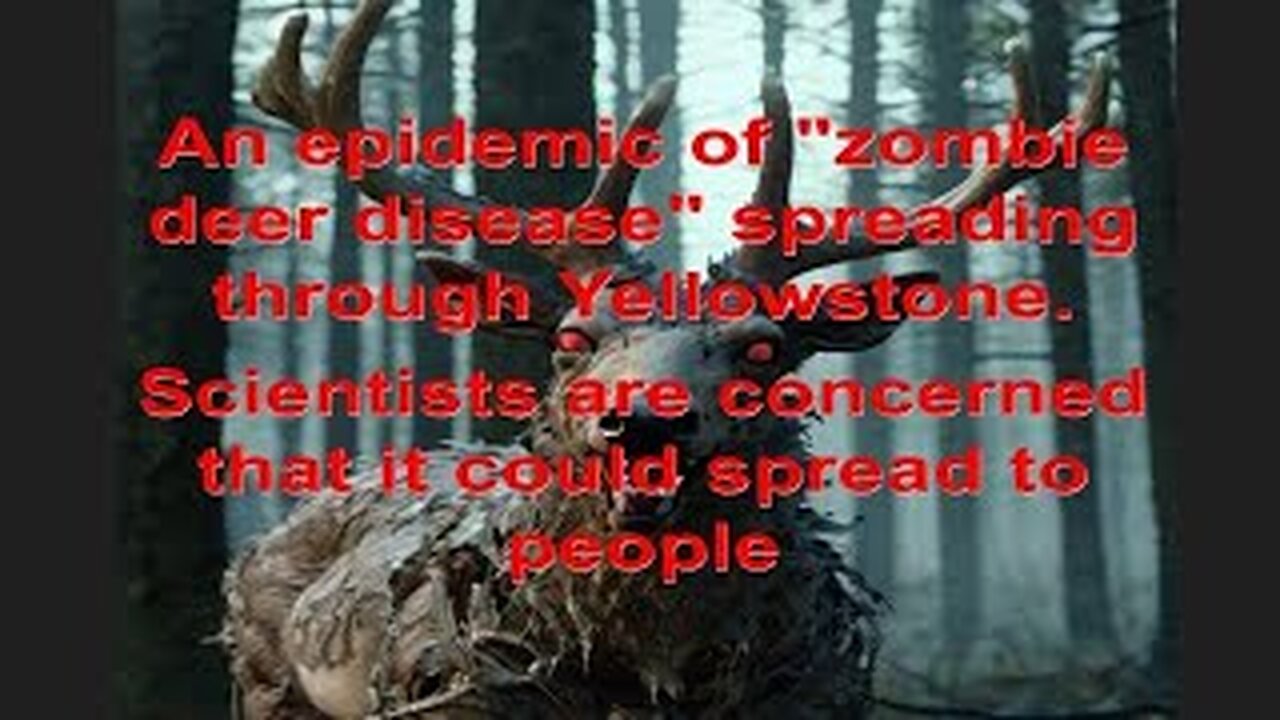Premium Only Content

An epidemic of zombie deer disease" spreading through Yellowstone.
An epidemic of zombie deer disease" spreading through Yellowstone. Scientists are concerned that it could spread to people. The confirmed case of chronic wasting disease (CWD) within the confines of Yellowstone National Park is setting off alarm bells amongst scientists and conservationists alike. CWD, colloquially termed "zombie deer disease" due to the symptomatic loss of awareness and coordination in affected animals, is a prion disease that has been progressively infiltrating deer populations across North America. The discovery in Yellowstone is of particular concern due to the park's status as a biodiversity stronghold. Different species of cervids—including deer, elk, moose, and others—are not only integral to the park's ecosystem but are also a keystone for the myriad predators such as grizzlies and wolves, and scavengers that thrive in the area. The fundamental problem with CWD lies in its nature and transmission. Prions are misfolded proteins that propagate by inducing normal proteins in the brain to misfold as well. This leads to brain damage and eventually death, with affected animals displaying drastic behavioral changes. The transmission can occur through direct contact or via the environment, as the prions are known to bind to soil particles and remain infectious for extended periods, making the pathogen's eradication almost insurmountable. There are no known cures or vaccines for CWD, and its deadly and contagious character spells a dire scenario for wildlife management. The disease can decimate cervid populations which, in turn, can radically shift the ecological balance in places like Yellowstone. The specter of CWD crossing the species barrier adds another dimension to the already pressing issue. The epidemic of Bovine Spongiform Encephalopathy (BSE), or mad cow disease, in the late 20th century is a harbinger of the implications of such a cross-species infection. BSE jumped from cattle to humans, leading to Creutzfeldt-Jakob disease, a fatal neurological disorder. While there have been no confirmed cases of CWD in humans, the potential remains a cause for concern. Epidemiologists caution against complacency, warning that the absence of a spillover into humans thus far is not definitive proof it cannot happen. The disease is reminiscent of other prion diseases like BSE, which blindsided health systems when it made the interspecies leap. The situation suggests that active and aggressive measures are required to monitor and manage the spread of CWD. This includes a robust wildlife surveillance program, funding for research into treatment and management strategies, and public education about the risks of consuming potentially infected meat. The Yellowstone case marks a critical juncture; it is both a call to action and a reminder of the delicate balance between humans, wildlife, and disease. Ensuring the park's wildlife is protected from CWD is not merely a conservation issue but also a matter of public health and ecological stewardship. With millions of visitors each year, the eyes of the public are squarely focused on how the US federal government and state authorities respond to this emerging challenge. This situation also underscores the importance of interdisciplinary approaches, combining ecology, veterinary science, and public health to address zoonotic and environmental risks posed by diseases like CWD. Effectively curbing the spread within Yellowstone could serve as a model for managing wildlife diseases worldwide, highlighting the necessity for concerted efforts in responding to such ecological threats.
-
 2:12:18
2:12:18
TheDozenPodcast
20 hours agoIslam vs Christianity: Bob of Speakers' Corner
31.1K10 -
 14:36
14:36
The StoneZONE with Roger Stone
1 day agoRoger Stone Delivers Riveting Speech at Turning Point’s AMFEST 2024 | FULL SPEECH
40.4K10 -
 18:59
18:59
Fit'n Fire
10 hours ago $2.23 earnedZenith ZF5 The Best MP5 Clone available
7.02K1 -
 58:34
58:34
Rethinking the Dollar
19 hours agoTrump Faces 'Big Mess' Ahead | RTD News Update
13.2K5 -
 5:35
5:35
Dermatologist Dr. Dustin Portela
19 hours ago $1.25 earnedUnboxing Neutrogena PR Box: Skincare Products and Surprises!
11.5K2 -
 11:20
11:20
China Uncensored
18 hours agoCan the US Exploit a Rift Between China and Russia?
27.2K15 -
 2:08:48
2:08:48
TheSaltyCracker
13 hours agoLefty Grifters Go MAGA ReeEEeE Stream 12-22-24
222K653 -
 1:15:40
1:15:40
Man in America
16 hours agoThe DISTURBING Truth: How Seed Oils, the Vatican, and Procter & Gamble Are Connected w/ Dan Lyons
130K119 -
 6:46:07
6:46:07
Rance's Gaming Corner
18 hours agoTime for some RUMBLE FPS!! Get in here.. w/Fragniac
165K4 -
 1:30:48
1:30:48
Josh Pate's College Football Show
17 hours ago $10.79 earnedCFP Reaction Special | Early Quarterfinal Thoughts | Transfer Portal Intel | Fixing The Playoff
98.1K1